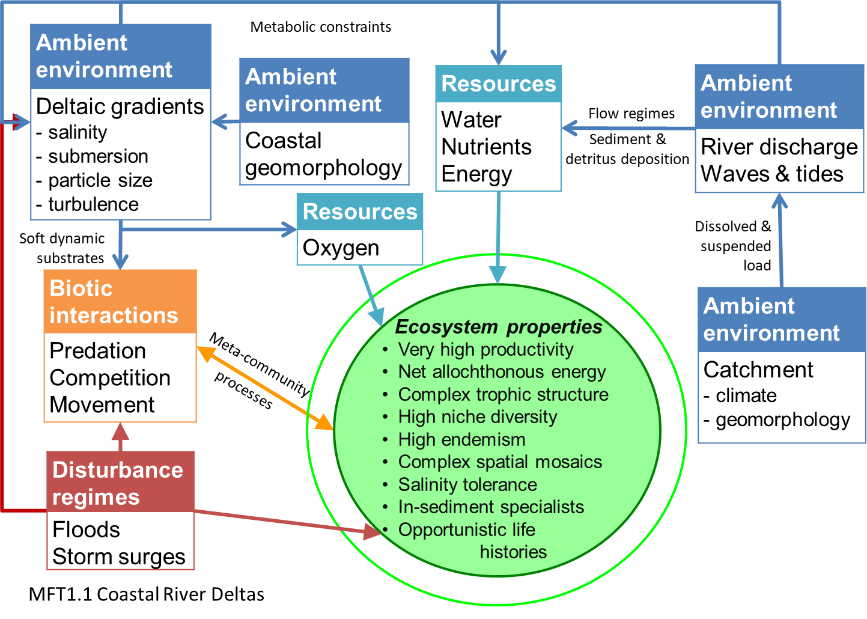Global ecosystem typology
Alternative site for the Global ecosystem typology with additional information for ecosystem profiles and indicative maps.
This site is maintained by jrfep
MFT1.1 Coastal river deltas
Biome: MFT1. Brackish tidal biome
Contributors:
(texts)
At the convergence of terrestrial, freshwater and marine realms, coastal river deltas are shaped by river inflows that deposit sediment and ocean tides and currents that disperse it. Gradients of salinity and submergence and dynamic substrates create shifting mosaics of channels, islands, floodplains, intertidal and subtidal mud plains and sand beds that may be regarded as embedded patches of other functional groups. The dynamic mosaics support complex foodwebs. Planktonic algae, aquatic plants and river inflows contribute detritus for in-sediment fauna. Fish and zooplankton are diverse and abundant in the water column, providing food for wading and fishing birds and marine and terrestrial predators.
Key Features
Depositional, mosaic systems with strong gradients between terrestrial, freshwater and marine elements. Productive with diverse plankton, fish, birds and mammals..
Overview of distribution
Continental margins of high rainfall catchments globally.
Profile versions
- v1.0 (2020-01-20):
- v2.0 (2020-05-28): DA Keith; RT Kingsford
- v2.01 ():
- v2.1 (2022-04-06): DA Keith; RT Kingsford Full profile available at official site
Main references
Selected references for this functional group:
Bianchi TS, Allison MA (2009) Large-river delta-front estuaries as natural “recorders” of global environmental change Proceedings of the National Academy of Sciences of the USA 106:8085-8092 DOI:10.1073/pnas.0812878106
Orton GJ, Reading G (1993) Variability of deltaic processes in terms of sediment supply, with particular emphasis on grain-size Sedimentology 40:475-512 DOI:10.1111/j.1365-3091.1993.tb01347.x
Diagrammatic assembly model

Maps
Maps are indicative of global distribution patterns are not intended to represent fine-scale patterns. The maps show areas of the world containing major (coloured red) or minor occurrences (coloured yellow) of each ecosystem functional group. See general notes on maps.
Information about the current valid indicative map for this functional group is shown below.
MFT1.1.WM.nwx_v1.0

Datasets
- Deltas-at-Risk
- Global-Delta-Data
Map references
Z.D. Tessler, C.J. Vörösmarty, M. Grossberg, I. Gladkova, H. Aizenman, J.P.M. Syvitski, E. Foufoula-Georgiou (2015) Profiling Risk and Sustainability in Coastal Deltas of the World Science 349(6248), 638-643 DOI:10.1126/science.aab3574
Nienhuis, J.H., Ashton, A.D., Edmonds, D.A. et al. (2020) Global-scale human impact on delta morphology has led to net land area gain Nature 577, 514–518 DOI:10.1038/s41586-019-1905-9
Check: the Glossary / Profile structure / the public document